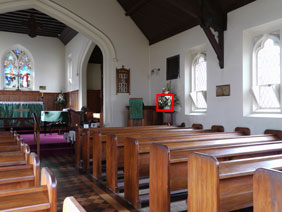Panasonic Lumix DMC-GH1
-
-
Written by Gordon Laing
Panasonic GH1 vs Nikon D90 vs Canon PowerShot SX1 IS
Panasonic Lumix DMC-GH1 results
High ISO noise
 |
To compare noise levels under real-life conditions we shot this scene with the Panasonic Lumix DMC-GH1, Nikon D90 and the Canon PowerShot SX1 IS within a few moments of each other using each of their ISO settings. The lenses on each camera were adjusted to deliver the same vertical field of view. The image left was taken with the Panasonic Lumix DMC-GH1 at 100 ISO with the G VARIO 14-140mm kit lens at 17mm f8; the original Large Fine JPEG measured 5.44MB. The crops are taken from the area marked by the red square and presented here at 100%. |
We’ve compared the Lumix GH1 kit against leaders in two quite different categories here to see how it measures-up. We selected the Nikon D90 for comparison here because it’s the current leader in high ISO performance for mid-range DSLRs, and therefore represents a serious challenge for the GH1 with its physically smaller sensor. The D90 also offers HD movies, albeit in the lower 720p format. Coincidentally if you swap the DX 18-105mm VR kit lens for the DX 18-200mm VR super-zoom, it also roughly matches the coverage of the GH1 kit for a price that’s only a little higher.
We selected the Canon PowerShot SX1 IS because it’s arguably the best hybrid compact to date, sporting Full HD 1080p movies and a 20x optical zoom range that boasts around double the maximum coverage of the GH1 and D90 super-zooms. The SX1 IS is also comparatively cheap at one half the price of the standard Nikon D90 / 18-105mm kit, or at almost one third the price of the GH1 kit or the D90 with the Nikkor 18-200mm lens.
Note the Nikon D90 captures wider 3:2 aspect ratio images, so by matching the vertical field of view, we’re effectively treating the DSLR here as a 10.8 Megapixel camera, delivering 4:3 shaped images.
The Canon PowerShot SX1 IS kicks-off the sequence at 80 ISO where it delivers a detailed image, albeit one that already has subtle noise textures in the background. It’s nothing to be too concerned about yet, but once again illustrates how modern compacts have visible noise even at their lowest sensitivities.
The Lumix GH1 and Nikon D90 join-in at 100 ISO, where both cameras deliver very clean, noise-free results that are packed with detail, although notice how the D90 has gone for a warmer white balance than the other two cameras.
The GH1 has an extra effective Megapixel over the D90 when their vertical field-of-view is matched, and as such shows a slightly tighter crop here, but the degree of real-life detail is roughly the same. The biggest difference between them (beyond the white balance) is greater sharpening by default on the part of the GH1. This sharpening is bringing out a few minor details beyond the D90, but apply a boost in the latter’s sharpening and you’ll achieve a similar result.
As for the PowerShot SX1 IS, this row of crops may only represent a 20 ISO increase over its base level, but noise levels have already become higher. They’re still relatively subtle, but when viewed side-by-side with the GH1 and D90 crops, they remain clear to see.
Doubling the sensitivity to 200 ISO has little or no impact on the GH1 and D90 crops as you’d hope, but again the PowerShot SX1 IS is suffering more.
At 400 ISO, pixel-peepers will notice very faint evidence of noise textures on both the GH1 and D90, but they’re really nothing to worry about, and as importantly both models remain roughly neck-in-neck. The SX1 IS is however suffering from a significant decrease in quality with visible noise, a reduction in saturation and loss of fine detail.
At 800 ISO the GH1 and D90 again show a subtle increase in noise artefacts, and if you’re being really fussy, the D90 takes a fractional lead here. But this is nit-picking: the GH1 may have subtle evidence of chroma artefacts, but most would be perfectly satisfied by the result here. In the meantime, the SX1 IS, like all compacts, has taken a serious turn for the worse with a sharp hike in artefacts and drop in detail.
With the sensitivity increased to 1600 ISO we can finally see a difference between the GH1 and D90 samples. Here the GH1 is now exhibiting greater noise speckles than the D90, and a softening of sharp edges, but the degree of retained detail remains respectable. The D90 sample may be cleaner, but it doesn’t sport any more detail; indeed the GH1 sample at 1600 ISO can be cleaned-up quite nicely with third-party noise reduction to achieve a similar result. As for the SX1 IS’s smudgy result, perhaps the less said, the better.
At 3200 ISO we’re at the upper-limit of the Lumix GH1, and while noise levels are again higher and saturation a little less there’s still plenty of detail there. The D90 remains impressively cleaner using its default settings, but again there’s not a great deal of difference in terms of fine detail. 3200 ISO is also the maximum sensitivity for the SX1 IS, at which point it drops the resolution to just 2 Megapixels in a Scene Preset mode.
The Nikon D90 completes the sequence as the lone model to offer a 6400 ISO option. Here noise levels are unsurprisingly becoming quite visible, but the degree of detail is still pretty good all things considered.
At first glance, the Lumix GH1 appears to roughly match the Nikon D90 up until the 1600 ISO mark, where noise levels on the Panasonic become more visible. This in itself isn’t a bad result at all for the Lumix GH1, given its physically smaller sensor, and the fact the D90 is a leader in high ISO performance. But look at those crops more closely and, as discussed above, you’ll see the amount of real-life detail delivered by both models is actually roughly the same. The D90 may be cleaner by default from this point on, but isn’t recording significantly greater detail.
So while we’d say the D90 enjoys around a one stop advantage over the GH1 in terms of visible noise levels from 1600 ISO upwards, the actual amount of detail recorded is very similar. This is a very impressive result for the Lumix GH1, given the larger sensor and proven reputation of its rival here. As for the PowerShot SX1 IS, it looks comparatively disappointing compared to the other two cameras here, but its results are par for the course for a compact with a relatively small sensor. It once again proves that if you want lower noise results, especially at higher sensitivities, you need a camera with a physically larger sensor. The Lumix GH1 however proves you don’t need to lug around a hefty traditional DSLR to enjoy this capability.
Now let’s check out some more real-life images taken across its sensitivity range in our Panasonic Lumix GH1 Sample Images Gallery.
Panasonic Lumix DMC-GH1 |
Nikon D90 |
Canon PowerShot SX1 IS | ||
 |
 |
 | ||
80 ISO not available |
80 ISO not available |
80 ISO | ||
 |
 |
 | ||
100 ISO |
L1.0 (100 ISO) |
100 ISO | ||
 |
 |
 | ||
200 ISO |
200 ISO |
200 ISO | ||
 |
 |
 | ||
400 ISO |
400 ISO |
400 ISO | ||
 |
 |
 | ||
800 ISO |
800 ISO |
800 ISO | ||
 |
 |
 | ||
1600 ISO |
1600 ISO |
1600 ISO | ||
 |
 |
 | ||
3200 ISO |
3200 ISO |
3200 ISO (at 2 Megapixels) | ||
 |
 |
 | ||
6400 ISO not available |
H1.0 (6400 ISO) |
6400 ISO not available |




